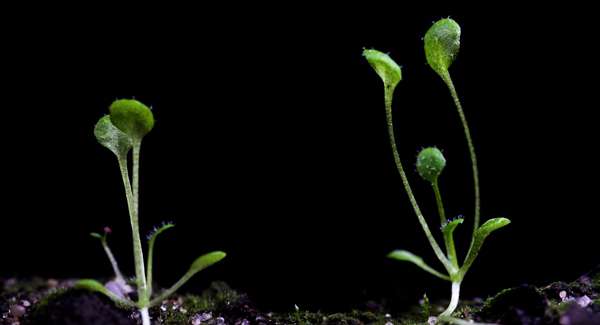Plants keep one foot on the brakes

Pressing on the gas and the brakes at the same time hardly sounds like good driving technique, but Weizmann Institute scientists have discovered that plants drive some of their key processes in precisely such manner.
A research team headed by Prof. Avihai Danon of the Plant and Environmental Sciences Department - postdoctoral fellow Dr. Erez Eliyahu and then graduate students Ido Rog and Inbal Dangoor - studied the mechanisms controlling the plant production of starch, which is the most common carbohydrate in the human diet and present in large amounts in such staple crops as rice, potatoes and maize. The plant starts making starch as soon as the morning light turns on its photosynthesis and stops when photosynthesis subsides at night.
About half a century ago, scientists discovered the "on" switch for starch production: a launch enzyme that is activated, via a series of regulatory proteins, by the flow of electrons generated in photosynthesis. Now in the new study, reported in the Proceedings of the National Academy of Sciences, (PNAS), Weizmann Institute scientists have discovered the "off" switch for starch production. Working with a mustard-like plant called Arabidopsis, they figured out the chain of biochemical events leading to its shutdown at night. The decrease in light causes a small signaling protein called ACTH4 to lose electrons and become oxidized, which, in turn, quickly prompts it to transmit the "take a break" message to the starch production enzyme.
The discovery of the "off" switch is significant in itself because the ability to rapidly shut down starch production on demand is an essential attribute of plant life. At night, the plant breaks down the starch - its major energy store - using it for growth and development. Should production fail to stop, the plant would enter a futile, energy-wasting cycle, in which it would mistakenly keep making new starch from the breakdown products.
In further investigating the shutdown mechanism, the scientists made yet another, entirely unexpected revelation. They realized that this mechanism remains active at a low level throughout the day. It's as if the plant drives its starch production by pressing on the gas pedal and the brakes simultaneously: turning the production on while at the same time keeping it in check. When the scientists genetically engineered the plants to eliminate the "brakes," starch production shot up by nearly 20 percent. This suggests that generally, production efficiency stands at only about 80 percent because the brake pedal is on all the time. In the future, this research may make it possible to increase starch production in agricultural crops.
Why do plants naturally produce starch in such an inefficient manner? The scientists believe that this seemingly wasteful approach in fact holds the key to a clever adaptation strategy.
Since light intensity, and with it the rate of photosynthesis, often fluctuates rapidly throughout the day, the plant needs to adjust its metabolism on an ongoing basis. In particular, starch synthesis needs to be closely attuned to photosynthesis so that the compounds created in photosynthetic reactions are promptly taken up - otherwise reactive oxygen molecules called free radicals, generated as a byproduct of photosynthesis, can build up to excessive levels, harming the plant.
Pressing their gas and the brake pedals simultaneously enables plants to control their starch production rapidly and effectively - by adjusting the relative strengths of the two pedals. Moreover, keeping the brake pedal lightly pressed all the time leaves room for a potential increase should sunlight suddenly become extremely intense. Indeed, the scientists found that when light intensity increased abruptly in their experiments, starch synthesis shot up transiently as well.
If plants were already making starch at full capacity, they couldn't increase its production any further - and would perish from the resulting excess of free radicals generated in the soaring photosynthesis. Keeping "one foot on the brakes" is therefore part of the sophisticated set of control mechanisms that has helped plants survive over hundreds of millions of years in an abruptly-changing and often unpredictable environment.
More information: Erez Eliyahu et al. ACHT4-driven oxidation of APS1 attenuates starch synthesis under low light intensity in plants , Proceedings of the National Academy of Sciences (2015). DOI: 10.1073/pnas.1515513112
Journal information: Proceedings of the National Academy of Sciences
Provided by Weizmann Institute of Science


















